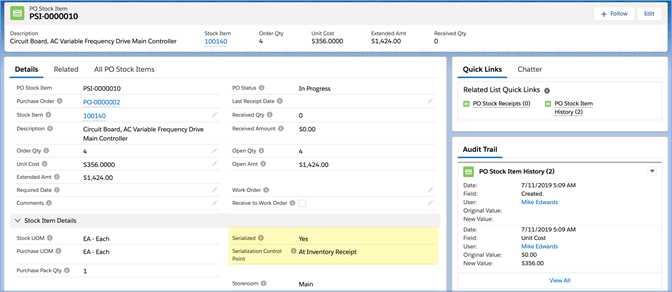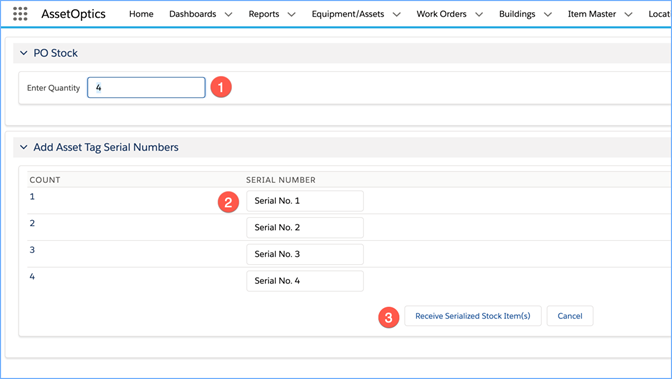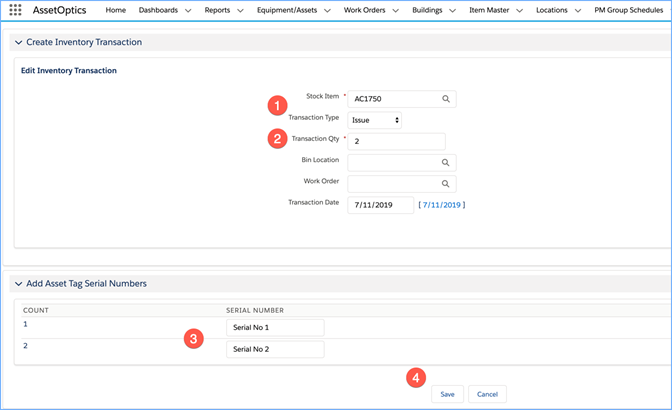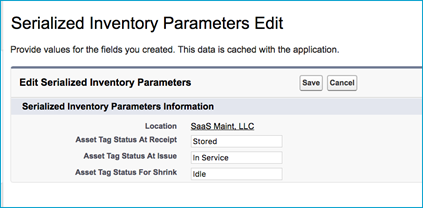Overview
AssetOptics provides the ability the ability to manage both bulk stock inventory and serialized inventory.
Bulk stock inventory tracks the on-hand quantity for a part within a specific inventory location. If there is an on-hand quantity of two or more, there is no difference between the physical items, and it does not matter which physical item is picked when issuing a part.
Serialized inventory tracks the on-hand quantity for a Stock Item AND a serial number for a specific unit. When a serialized part is issued from stock, it does matter which unit is selected. A serialized part is treated as both a stock inventory item and an asset. The serialized units may be placed into service, removed, repaired, returned to stock and re-issued for service. The lifecycle of a serialized unit can be tracked independently of the position where it is installed. This business problem is commonly referred to as “rotating spares” or “repairable spares”.
Serialized Stock Items Field Definitions
Figure 1 – Serialized Component Setup section of the Stock Item page layout.
There are four specific data fields on the Stock Item that determine if it is bulk stock or serialized;
- Serialized
- Serialization Control Point
- Condition
- Asset Tag Record Type
Serialized, Serialization Control Point and Asset Tag Record Type are dependent picklists.
For bulk stock inventory, the Serialized attribute should remain as the default value of “No”.
For serialized inventory, set the Serialized picklist to “Yes”, choose a Serialization Control Point and an Asset Tag Record Type.
There are two options for Serialization Control Point; “At Inventory Receipt” and “At Inventory Issue”.
“At Inventory Receipt” means the Serial Numbers, which also serve as the Asset Tag ID, must be specified at the time that inventory is introduced into the system; i.e. during any transaction that adds on hand quantity such as a gain adjustment or a receipt on a Purchase Order. During the Purchase Order receiving process, an Asset Tag record will be created as inventory is added. During a Gain adjustment, you must select an existing Asset Tag record. When you issue the serialized service part from inventory, you will be required to select the specific serial number.
“At Inventory Issue” means that the Serial Numbers are specified when the part is issued from stock. When you issue the service part from stock inventory, you will be prompted to enter a Serial Number. An Asset Tag record will be created as you issue the Service Part.
Condition is a user defined picklist with the pre-populated values of New, Used and Refurbished.
Asset Tag Record Type is a user defined picklist. This field determines what Asset Tag Recordtype will be used when an Asset Tag record is created for the specific Stock Item. By default, there are two values in this picklist; Equipment and Component. You may enter additional values in the Asset Tag picklist field labeled “Asset Tag Record Type”. The values entered in this picklist must EXACTLY match the Name of the Asset Tag recordtype that will be created from the Stock Item. Any mismatches will result in APEX errors during transaction processing.
Please note that the term Asset Tag and Equipment/Asset are used interchangeably.
Serialized Inventory Process
Receiving on a Purchase Order
A Stock Item is ordered thru a Purchase Order by entering a PO Stock Item record. See Purchasing Stock Items for further details. When receiving a Stock Item on a PO Stock Item line, the user must know if the item is serialized, and if so, what is the Serialization Control Point setting. Both the Serialized and Serialization Control Point values are displayed in the Stock Item Details section of the page.
If the Stock Item Serialization = No, then the item is bulk inventory and only a “quantity” will need to be specified when received.
If the Stock Item Serialization = True and the Serialization Control Point = At Inventory Issue, then the item is treated as bulk inventory while in the Storeroom and thus only a “quantity” will need to be specified when received.
If the Stock Item Serialization = True and the Serialization Control Point = At Inventory Receipt, then serial numbers must be entered at the time of PO Stock Receipt.
Please note that all PO Stock Receipts increase the On Hand Qty in the Primary Bin/Inventory Location. If you desire to transfer the items to a secondary bin, you must separately perform a Bin Transfer.
PO Stock Item Detail Page Layout
Create a new PO Stock Receipt by selecting the New command button on the PO Stock Receipts related list.
- The Open Qty for the PO Stock Item line will default as the Received Qty. If you are performing a partial receipt, update the receipt quantity as needed.
- Enter Serial Numbers for the received Stock Items. The total count of the serial numbers to enter will take into consideration the Purchase Pack Qty; i.e. if you stock in the “EA-Each” and order in a “BX-Box” of 4, there will be 4 serial numbers to enter for each quantity of “1” specified in the receipt qty.
- Select the Receiver Serialized Part(s) command button.
When the Serialized Stock Items are received, an Equipment/Asset record will be created for each unit. The On Hand Qty for the Stock Item will be increased.
At Inventory Issue
If the Serialization Control Point is set to “At Inventory Issue”, then the Stock Item is treated like a bulk stock inventory item on Purchase Orders and also while it resides in the On Hand Qty in the Storeroom. When a unit is Issued from inventory, you will be required to create a new Serial number for each unit issued.
Please take note that if you setup a Stock Item with the Serialization Control Point of “At Inventory Issue” and you wish to manage repairable spares, you will also need to setup an identical Stock Item linked to the same Item Master record in the same Storeroom with the condition attribute of Used or Refurbished. The Serialization Control Point of this second Stock Item will need to be set to “At Inventory Receipt”. This approach will enable you to manage new units as bulk inventor
Once the Asset Tag records are created, you will want to maintain the history of that specific unit, thus the need for similar Service Parts.
Setup & Configuration
There are three Asset Tag Statuses that can be configured in a Custom Setting labeled “Serialized Inventory Parameters”. To access the Custom Setting, navigate to Setup > Custom Code > Custom Settings (Setup > Build > Develop > Custom Settings in Classic Setup). Serialized Inventory Parameters is a hierarchical custom setting. It is recommended that you set the values only at the Organization level. For more information on Custom Settings, please refer to the Salesforce community.
Serialized Inventory Parameters Custom Setting
You can enter a text string value in the custom setting. Accept the default values unless you wish to custom configure the process. The text string must EXACTLY match (Case Sensitive) an Active picklist value for the Asset Tag Status field. Any mismatches will result in APEX errors during transaction processing. If AssetOptics support or consulting services assisted with the initial setup of your org, these values will likely have been entered.
Asset Tag Status At Issue – This value represents the Asset Tag Status that will be set to the selected Asset Tag record when issuing a serialized part from inventory.
Asset Tag Status At Receipt – This value represents the Asset Tag Status that will be set to the selected Asset Tag record when receiving a serialized part on a Purchase Order and adding to inventory. This value is also used when performing a Gain Type Inventory Transaction to return a Serialized Stock Item to inventory.
Asset Tag Status for Shrink – This value represents the Asset Tag Status that will be set to the Asset Tag record when it is selected during a Shrink Type Inventory Transaction. This is also the Status that must be set for an Asset Tag record to be selected when performing a Gain Type Inventory Transaction.
Setting up a new Serialized Stock Item
- Create a new or identify an existing Item Master record.
- Create a new Stock Item record.
- Enter the Item Master on the Stock Item record.
- Set Serialized = Yes
- Set the Serialization Control Point = At Inventory Receipt (unless otherwise directed).
- Set the Asset Tag RecordType = Component (unless otherwise directed).
- To add new serialized stock items to inventory
- Purchase Order
- Process a Purchase Order for the Stock Item.
- Receive to inventory.
- Inventory Transaction – Gain Adjustment
- Identity an existing or create a new Asset Tag record.
- Update the Item Master on the Asset Tag record.
- Edit Status = Idle
- Create a Gain adjustment on the Part record return asset to stock inventory.
- Purchase Order
Recommended Rotating Spares Lifecycle
Tips:
- When you issue a Serialized Part from inventory, the Status will be set to that which is defined in the custom setting. Update the Parent Asset to introduce the Asset Tag into a hierarchy. Add or activate an PM Schedules as needed.
- If you create a Purchase Order for an outside vendor to repair the spare part, create a Misc Cost line to represent the repair service. Do not create a PO Part line for the Part itself.





